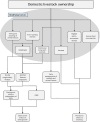Perspective: Connecting the dots between domestic livestock ownership and child linear growth in low- and middle-income countries
- PMID: 38192051
- PMCID: PMC10981488
- DOI: 10.1111/mcn.13618
Perspective: Connecting the dots between domestic livestock ownership and child linear growth in low- and middle-income countries
Abstract
Child stunting due to linear growth faltering remains a pervasive issue in low- and middle-income countries. Two schools of thought have existed pertaining to the role of domestic livestock ownership (DLO) in child linear growth. On one hand, it is argued that DLO leads to greater income and financial security, resulting in better child-raising conditions, including greater animal-source food (ASF) consumption, having protective effects towards child stunting. On the other hand, researchers argue that DLO contributes to faecal contamination and transmission of zoonotic enteric infections from animals to children, thus having destructive effects on child growth. Reviews of this association have revealed ambiguous findings. In this perspective, we argue that measuring the association between exposures to domesticated animals and child stunting is difficult and the ambiguous associations revealed are a result of confounding and differences in the management of DLO. We also argue that the increasingly prominent area of research of environmental enteric dysfunction, a sub-clinical condition of the small intestine thought to be due to frequent faecal pathogen exposure and associated with stunting, will be a useful tool to measure the potential destructive effects of DLO on child growth. We present our argument and identify challenges and considerations and directions for future research.
Keywords: animal faeces; animal source foods; child stunting; domesticated animals; environmental enteric dysfunction; linear growth faltering; low‐ and middle‐income countries.
© 2024 The Authors. Maternal & Child Nutrition published by John Wiley & Sons Ltd.
Figures
Similar articles
-
The Relationship between Livestock Ownership and Child Stunting in Three Countries in Eastern Africa Using National Survey Data.PLoS One. 2015 Sep 11;10(9):e0136686. doi: 10.1371/journal.pone.0136686. eCollection 2015. PLoS One. 2015. PMID: 26361393 Free PMC article.
-
Livestock Ownership Among Rural Households and Child Morbidity and Mortality: An Analysis of Demographic Health Survey Data from 30 Sub-Saharan African Countries (2005-2015).Am J Trop Med Hyg. 2017 Mar;96(3):741-748. doi: 10.4269/ajtmh.16-0664. Epub 2017 Apr 6. Am J Trop Med Hyg. 2017. PMID: 28044044 Free PMC article.
-
Assessing the Impact of Animal Husbandry and Capture on Anemia among Women and Children in Low- and Middle-Income Countries: A Systematic Review.Adv Nutr. 2019 Mar 1;10(2):331-344. doi: 10.1093/advances/nmy080. Adv Nutr. 2019. PMID: 30854553 Free PMC article.
-
A Systematic Review Investigating the Relation Between Animal-Source Food Consumption and Stunting in Children Aged 6-60 Months in Low and Middle-Income Countries.Adv Nutr. 2019 Sep 1;10(5):827-847. doi: 10.1093/advances/nmz018. Adv Nutr. 2019. PMID: 31177279 Free PMC article.
-
Livestock production, animal source food intake, and young child growth: the role of gender for ensuring nutrition impacts.Soc Sci Med. 2014 Mar;105:16-21. doi: 10.1016/j.socscimed.2014.01.001. Epub 2014 Jan 11. Soc Sci Med. 2014. PMID: 24606793
Cited by
-
Livestock ownership, ASF consumption and child nutrition in Rwanda: a multilevel mixed effect approach.Sci Rep. 2025 Aug 19;15(1):30443. doi: 10.1038/s41598-025-97365-w. Sci Rep. 2025. PMID: 40830594 Free PMC article.
-
Who has sheds? Exploring practices and determinants of overnight housing for backyard poultry in rural Bangladesh to inform an intervention to limit exposure to poultry and poultry feces.PLOS Glob Public Health. 2025 Jul 22;5(7):e0004929. doi: 10.1371/journal.pgph.0004929. eCollection 2025. PLOS Glob Public Health. 2025. PMID: 40694593 Free PMC article.
-
Factors influencing livestock ownership and herd intensity among smallholder farmers in the Eastern Cape, South Africa.Heliyon. 2025 Jan 8;11(2):e41787. doi: 10.1016/j.heliyon.2025.e41787. eCollection 2025 Jan 30. Heliyon. 2025. PMID: 39877621 Free PMC article.
References
-
- Akseer, N. , Tasic, H. , Nnachebe Onah, M. , Wigle, J. , Rajakumar, R. , Sanchez‐Hernandez, D. , Akuoku, J. , Black, R. E. , Horta, B. L. , Nwuneli, N. , Shine, R. , Wazny, K. , Japra, N. , Shekar, M. , & Hoddinott, J. (2022). Economic costs of childhood stunting to the private sector in low‐ and middle‐income countries. EClinicalMedicine, 45, 101320. - PMC - PubMed
-
- Black, R. E. , Victora, C. G. , Walker, S. P. , Bhutta, Z. A. , Christian, P. , de Onis, M. , Ezzati, M. , Grantham‐McGregor, S. , Katz, J. , Martorell, R. , & Uauy, R. (2013). Maternal and child undernutrition and overweight in low‐income and middle‐income countries. The Lancet, 382(9890), 427–451. - PubMed
-
- Budge, S. , Hutchings, P. , Parker, A. , Tyrrel, S. , Tulu, T. , Gizaw, M. , & Garbutt, C. (2019). Do domestic animals contribute to bacterial contamination of infant transmission pathways? Formative evidence from Ethiopia. Journal of Water and Health, 17(5), 655–669. - PubMed
-
- Chan, M. Y. , & Smith, M. A. (2018). 5.16—Infections in pregnancy. In McQueen C. A. (Ed.), Comprehensive toxicology (3rd ed., pp. 232–249). Elsevier.
MeSH terms
LinkOut - more resources
Full Text Sources


